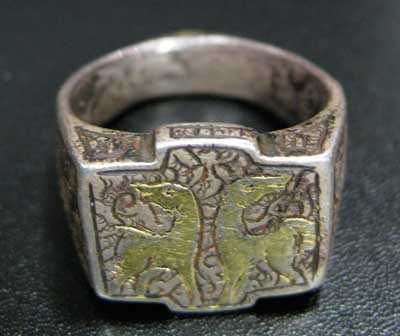Seljuk Incised Silver Ring with Gold Inlay, 1100 CE - 1400 CE
Silver, Gold
OS.201
In the 9th century, hordes of nomadic Turkic horseman living on the outskirts of the Muslim world began to migrate westward into the heart of Central Asia. By the 10...
In the 9th century, hordes of nomadic Turkic horseman living on the outskirts of the Muslim world began to migrate westward into the heart of Central Asia. By the 10 century, a branch known as the House of Seljuk had broken off from the Oghuz confederation of Turkomen tribesmen, arrived into mainland Persia, and settled in the province of Khurasan. Overtime, the Seljuks converted to Islam and began to adopt the Persian language and culture. In the 11th century, the Seljuks set up an independent state under their leader Tugrul Bey with its capital in Isfahan, initially under the auspices of the Abbasid Caliph in Baghdad. The arts thrived during the Seljuk period as the Turkic rulers patronized Persian culture, arts, and literature.
However, as the Arab caliph began to disintegrate, the Seljuks seized the opportunity to expand their empire westward to the Levant and Anatolia where they frequently came into direct conflict with the Byzantines. In the famous Battle of Manzikert, the Seljuks dealt the Byzantines a decisive defeat, capturing Emperor Diogenes himself, paving the way for Turkic expansion into Anatolia and the signaling the decline of the mighty Byzantines. This golden era did not last long though, as increasing waves of clans migrating from the east, pushed westward by the Mongol onslaught, coupled with Crusader armies arriving from the European west, started to destabilize the empire.
The Great Seljuk Empire was reduced to a series of smaller principalities based in Anatolia, the most prominent and powerful of which was the Sultanate of Rum. The arrival of the Mongols themselves on the Anatolian plateau in the 13th century marked the end of Seljuk independence as they were forced to become vassals to the Mongols. Despite efforts to maintain the authority of the Sultan in the face of Mongol retreat, the Seljuks completely disintegrated as a political force in the first decade of the 14th century, leaving behind numerous small mini-states most of which remain obscure, except that one led by Osman I known as the Ottomans.
However, as the Arab caliph began to disintegrate, the Seljuks seized the opportunity to expand their empire westward to the Levant and Anatolia where they frequently came into direct conflict with the Byzantines. In the famous Battle of Manzikert, the Seljuks dealt the Byzantines a decisive defeat, capturing Emperor Diogenes himself, paving the way for Turkic expansion into Anatolia and the signaling the decline of the mighty Byzantines. This golden era did not last long though, as increasing waves of clans migrating from the east, pushed westward by the Mongol onslaught, coupled with Crusader armies arriving from the European west, started to destabilize the empire.
The Great Seljuk Empire was reduced to a series of smaller principalities based in Anatolia, the most prominent and powerful of which was the Sultanate of Rum. The arrival of the Mongols themselves on the Anatolian plateau in the 13th century marked the end of Seljuk independence as they were forced to become vassals to the Mongols. Despite efforts to maintain the authority of the Sultan in the face of Mongol retreat, the Seljuks completely disintegrated as a political force in the first decade of the 14th century, leaving behind numerous small mini-states most of which remain obscure, except that one led by Osman I known as the Ottomans.



